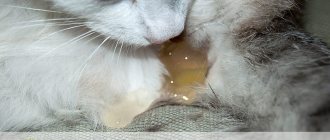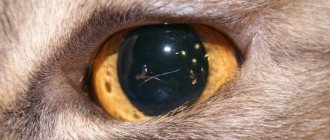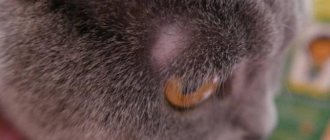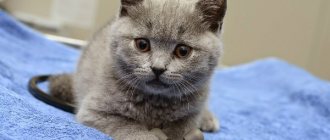Cutaneous horn in cats is a rather rarely diagnosed pathology in traditional veterinary medicine, which is characterized by the appearance of a horn-like conical, cylindrical keratin growth up to 5 cm in length.
In appearance, the formation, consisting of hard acellular keratin, resembles a claw or horn of light or dark color. Most often in cats, the pads of the paws are affected, less often on the face, in the area of the nose, eyelids, and genitals. The disease has a benign course.
How to treat cutaneous horn in a cat
Often, cat owners mistake the cutaneous horn for a second claw, which is not surprising, because in appearance the growth really resembles a claw.
An animal with this pathology can live its entire life without experiencing discomfort or pain. However, the disease should not be ignored. If you notice that your pet's growths are growing, consult a doctor immediately, as this sign may indicate the presence of a malignant tumor. So, how to recognize the disease and how to treat cutaneous horn in cats - let’s figure it out together with the site Koshechka.ru.
Symptoms and causes
The cutaneous horn of a cat has a dense consistency, it is conical in shape, light or dark in color. The surface of the neoplasm is pleasant to the touch, but due to the grooves, roughness may be observed. Such “horns” grow on the paw pads, genitals, nose and even eyelids. The size of the growth is about 5 cm in length.
Usually, the cutaneous horn does not cause pain in the cat and is a benign neoplasm. But if you press on it, it will be unpleasant for the animal, since inflammatory processes are still present, occurring in an imperceptible form. According to statistics, no more than 5% of neoplasms develop into a malignant form.
Why does cutaneous horn occur? The development of this pathology in cats may be due to various reasons. The most common of these include papillomavirus, leukemia or cyst. Scottish and British cats are especially susceptible to such diseases. Even a simple injury can lead to the formation of a growth.
Important! To avoid worsening the situation, never try to cut off the “horns” yourself. It is better to seek help from a clinic, where a veterinarian, based on the results of histological analysis, will establish an accurate diagnosis and prescribe the necessary course of treatment.
Cutaneous horn in cats: basic treatment methods
The most popular methods for combating growths include: medication, surgery, laser, cryotherapy. The decision on the appropriate method is made by the doctor, however, none of the treatment methods gives a 100% guarantee that the skin horn will not appear again after some time.
The surgical method involves excision of the tumor using a scalpel; it is recommended if the growths spread over a large area.
After the procedure, stitches are applied, which are removed after about 10 days.
Disadvantage: a scar may remain, and there is also a high risk of new growths, since during the operation there is contact with the animal’s blood, and the virus does not disappear from the body.
The most modern treatment options include laser and cryotherapy. These procedures help eliminate the virus and do not leave any traces on the animal’s body.
During laser surgery, there is no contact of medical instruments with the skin, which deprives the pet of any unpleasant sensations. But cryotherapy can become very painful for him.
The area where the horn grows is treated with liquid nitrogen, after which a dry crust appears at the site of the new growth.
How to treat a cat with pharmaceuticals?
In mild cases of the disease, doctors advise treating cutaneous horns in cats with pharmaceutical products that stop their further growth. On the website ko6e4ka.ru. we will look at the most effective medicines to eliminate the disease:
A drug such as “Etretinate”, prescribed at a dose of 1 mg/kg of animal weight, has proven itself well. The medicine should be used with extreme caution, as it tends to accumulate in the body.
- Azithromycin is an effective and inexpensive drug used in a dose of 10 mg/kg of cat weight. The animal is given tablets once a day, the course of treatment usually lasts up to 14 days. It is not recommended to take if the cat has liver or kidney dysfunction.
- “Acitretin” is eliminated from the body much faster and has a shorter half-life, unlike the above drugs. The medicine has side effects and is used under the strict supervision of a specialist.
- Aldara cream is applied in a thin layer of a ball onto the clean surface of the problem area and gently rubbed in until completely absorbed. The cream is recommended to be used 3 times a week. Also make sure that the animal does not lick the product after applying it.
ethnoscience
Using traditional medicine recipes, you can stop the development of the disease, but it will not be possible to completely cure your pet.
Typically, traditional medicine is used during the first stage of the disease; to achieve positive results, treatment must be long and continuous.
We offer several options for anti-growth recipes that can easily be prepared at home:
- Pour 100 g of unripe walnut fruits with hot vegetable oil, then infuse the resulting mixture for 24 hours. Then gently lubricate the problem area. Repeat this procedure for two weeks.
- Grind the bay and juniper leaves (6 pieces each). Then add a piece of butter (20 g), 15 drops of lavender or fir oil. Mix everything thoroughly.
- Secure a piece of propolis to the damaged surface with a bandage. The procedure must be repeated at least three times a week.
- Grind dry celandine leaves in a mortar and mix with rendered pork fat. The cream is applied to the painful area 3-4 times a week.
- Wipe the growths daily with any vegetable oil that is present in the house. The oil helps eliminate grooves from the surface of the skin horn.
- Cut a small aloe leaf, leave it in the refrigerator for 3 days, then apply the leaf to the affected area, securing it with an adhesive plaster.
- Rinse and dry 4 handfuls of onion peels. Then put them in a jar and fill them with 6% vinegar (1 cup). Infuse the infusion in a dark place for about 10 days. Then strain it and apply it to the tumor as a compress.
Now you know how to recognize cutaneous horn in a cat and how best to treat it. Try to take your pet to see a doctor at least twice a year. Don't neglect the health of your little friend.
This article has been checked and approved by a veterinarian. Knyazeva Anna Vladimirovna, veterinarian in private practice, Moscow. more about the expert.
(you can pay for the article) Loading... cat health, cutaneous horn, cat
Source: https://www.ko6e4ka.ru/koshki-vyros-kozhnyj-rog.htm
First aid
If the appendage does not cause pain to your pet or provoke other symptoms, then you can try to deal with the skin horn yourself. To do this, it is recommended to purchase a special tool:
- Etretinate is a medicine that reduces the growth of skin tissue. Given depending on the body weight of the animal (no more than 1 mg per 1 kg of weight). It is not recommended to exceed the dosage, as the medicine can accumulate;
- Aldar is a cream that is also used to combat overgrown tissues. The product is rubbed onto clean skin until absorbed. Frequency of application – 3 times in 7 days. The cat should not lick the cream from its paws;
- Acitretin is a medicine used only after veterinarian approval, as it exhibits dangerous side effects;
- Azithromycin - tablets that help to successfully get rid of the appendage. It is recommended to give them once a day. The duration of treatment is 14 days.
These remedies will help with growths formed not due to disease. If the pet's condition worsens, a veterinarian's examination is required.
What causes growths on cats' paws?
For some time, growths on the paws of cats that walk outside may be perceived as dirt. But, alas, there are several more serious reasons for this phenomenon. Sometimes in such cases even surgical intervention takes place. You can make a preliminary diagnosis yourself, but still only a veterinarian can give an unambiguous and accurate answer.
Why do they appear?
Small growths on the paw pads can be shaped like a small claw, which is why this symptom is also called cutaneous horn. It can have a completely different color: from light, almost transparent, to dark. Its surface is slightly rough and heterogeneous.
This texture is due to the presence of small grooves. In most cases, these growths do not pose a threat to the health and life of the pet, but there are some exceptions to this statement.
To summarize, we can identify 5 main reasons for the appearance of such formations:
- trauma (after injury, the pet’s skin may not heal properly, as a result of which the tissues may layer and form a growth);
- keratosis (irritation resulting from contact with aggressive chemical compounds);
- bacterial or viral infection (some infections can also cause skin horn formation, such as papillomavirus or leukemia);
- the presence of cancer (sometimes the cause of the growth is sarcoma, basal cell carcinoma, carcinoma or squamous cell carcinoma);
- cyst (appears in rare cases, but requires a responsible approach).
Some breeds have an increased tendency to form cutaneous horns, for example, growths on the paws of the British are diagnosed several times more often than in other representatives of the cat family. Due to the likelihood of quite serious illnesses, the owner should not remain indifferent. It is also not recommended to make a diagnosis on your own, much less prescribe treatment.
Associated symptoms
The cutaneous horn in pets is most often benign in nature, but still about 5% of cases are cancer cells. To protect your pet from premature death, you need to conduct a correct examination. To do this, you need to closely monitor the animal’s behavior and report accompanying symptoms to the doctor.
Growths on the hind legs of cats can be completely painless, or they can cause pain to the kitten. In such cases, the pet begins to constantly lick its paw, hide it under itself and limp on its front or back paw. Such behavior indicates that a trip to a veterinary medicine specialist is urgent.
But it is just as important to consult a specialist if the following symptoms appear:
Such complications indicate the development of cancer in the animal’s body. In this case, you need to prepare for complex and lengthy treatment, the result of which depends on timely access to a doctor, a responsible attitude of the owner and positive attention for the pet.
Important!
It is worth noting that cats with weakened immune systems, metabolic disorders and old age are prone to the development of such pathologies.
Photos of cats with growths on their paws
The initial examination of the animal involves feeling the growth and visually assessing the situation. If the presence of an injury or splinter is excluded, then a series of examinations are prescribed, which include:
- serological studies;
- bacterioscopic studies;
- screening for the presence of viral infections;
- histological studies;
- in severe cases, differential diagnosis and biopsy.
Among other things, the animal must be examined for virus carriage. This disease can be harmful not only to your furry pet, but also to humans.
Most often, veterinarians decide to remove the growth, but if the growth on the cat’s front paw does not receive any confirmation of malignancy, then it is possible to avoid this process. In this case, regular monitoring by a doctor is mandatory.
In the initial stages, treatment with synthetic retinoids is possible. Among others, the following drugs may be prescribed:
- Etretinate;
- Azithromycin;
- Aldara ointment;
- Acitretin.
Excision of the growth occurs under general or local anesthesia using laser removal or cryo-laser therapy.
If cancerous tumors are detected, chemotherapy, hormonal therapy, and immunostimulation are performed. The main rule for a quick recovery is a timely visit to a veterinarian.
He will select effective treatment and prevent the progression of the disease.
Source: https://okoshkah.com/narosty-na-lapah-u-koshek.html
What causes growths on cats' paws?
Changes in the structure of claws and paw pads, the formation of growths or warts in cats - all this should alert the owner. Growths on the paws of cats are a fairly common pathology and are found in all representatives of the species, regardless of breed. Such neoplasms can cause discomfort to the animal and therefore require treatment.
What is "cutaneous horn"?
New growths on the paws near the claws are called “cutaneous horn”. This name is due to the fact that the growths usually have a dense structure and resemble an extra claw. They are nothing more than tissue proliferation due to keratinization. The causes of the formation of such growths are in most cases viral.
The growths on the paws of Brittanys and other breeds are usually a different color from the paw pads and nails. They can be light, almost white, or dark brown.
Their nature is in many ways similar to ordinary warts. Growths are also caused by papillomavirus, of which there are several dozen.
Leukemia can also provoke proliferation and keratinization (excessive formation of keratin in the epidermis).
The growth itself is in most cases not dangerous and does not cause discomfort to the pet. However, neoplasms require careful monitoring. You should show the animal to a veterinarian and conduct a series of examinations to confirm the benign nature of the growth.
Reasons for the formation of growths
As mentioned above, growths are most often a consequence of the activity of the papillomavirus. Animals are susceptible to this disease to the same extent as people. Infection with the virus occurs against a background of weakening of the body.
Indirect causes of the appearance of tumors on the paws can be considered:
- Decreased immunity.
- Metabolic disorder.
- Elderly age.
- Viral diseases.
- Claw injuries.
Separately, oncological diseases are identified as the cause of the appearance of growths. In cancer, the “skin horn” is a consequence of systemic disorders in the body. Also, growths can appear in response to chemotherapy and other drugs for the treatment of cancer. This is associated with a decline in immunity.
Popular What causes a cat's teeth to become loose?
Severe damage to the claw, for example, as a result of a conflict with a relative or a blow, can lead to the appearance of growths on the cat’s paws. This is explained by the fact that at the site of injury, intensive release of keratin begins and the rate of division of epidermal cells changes, which leads to the formation of the so-called second claw.
Another cause of “cutaneous horn” is keratosis. The disease is characterized by the formation of areas of keratinized epidermis.
Such areas differ in color from healthy skin, the epidermis becomes hard and rough, and peeling is possible. Keratosis is a consequence of the negative effects of household chemicals or sunlight on an area of the skin.
Epidermal disease can develop after injuries, burns or prolonged contact with chemicals.
Why is “skin horn” dangerous?
In most cases, growths on the hind legs of cats are not dangerous and can be successfully treated with both medication and surgery. However, before starting treatment, it is imperative to conduct a histological analysis of the tumor - this will exclude oncology.
Large, dense growths on the paws lead to poor circulation, which may be accompanied by brittle nails or ingrown nails. Often inflammation begins around the growth.
Despite its benign nature, “skin horn” can lead to the development of oncology – squamous cell carcinoma. If the growths are caused by leukemia, there is a high risk of death.
Treatment methods
If you notice a growth on a cat's front paw, you should consult a specialist, but do not try to treat the animal yourself. First of all, it is necessary to exclude oncology and identify the causes of tumors.
If there is only one growth and is small in size, drug treatment at home is practiced. For this purpose, use:
- Aldara ointment;
- Azithromycin tablets;
- Etretinate;
- Acitretin.
Synthetic retinoids should only be used as prescribed by a doctor. The dosage is selected individually in each case and depends on the cat’s weight and general health.
It is important to understand that a course of drug therapy is not a 100% guarantee of complete recovery. The growths go away under the influence of synthetic retinoids, but over time they may appear again.
Popular What can cause a cat to foam at the mouth?
Several large growths on the paws are a reason for surgical treatment. In this case, surgery is preferable, as it eliminates tumors quickly and effectively. Both traditional removal of tumors using a scalpel and more modern methods are practiced - laser removal or cryodestruction of growths.
Source: https://KozhaKoshek.com/narostyi-na-lapah-u-koshek.html
When to contact a specialist?
It is necessary to visit a veterinarian if there are a large number of growths on the back legs of cats (or on the front legs). If your pet is unwell and the regular occurrence of pain during the animal’s movements should also be a cause for concern.
In addition to drug treatment, the veterinarian may offer the following treatment options:
- Laser surgery. In this way, it is possible to safely get rid of the growth on the animal’s paws. The laser leaves no traces and allows you to effectively fight the virus;
- Surgical method. Used if the area of build-up is too large. Using a scalpel, skin pathology is eliminated, however, after the operation, scars may remain and formations may reappear;
- Cryotherapy. This is a painful procedure, as the skin lesion is treated with liquid nitrogen. A dry crust appears at the site of the growth after the procedure;
None Some cat owners use traditional methods to treat growths. These include the use of aloe leaves, propolis, juniper and bay leaves, as well as the use of vegetable oil.
You can prevent the occurrence of such a pathology if you carefully monitor your pet’s health. It is important to notice changes in his health and undergo a preventive examination with a veterinarian twice a year.
Text of the article and photos from the book SMALL ANIMAL DERMATOLOGY A COLOR ATLAS AND THERAPEUTIC GUIDE 2021 Translation from English: veterinarian Vasiliev AV
[custom_ads_shortcode2]
Do I need to remove growths on my cat's paw pads?
Growths on the paw pads of cats are not considered uncommon. They look different, some are scary, others are harmless. They can cause discomfort to the pet, which will certainly affect walking.
Appear at any age, regardless of gender. Most often, animals with problems with excess weight, leukemia and immunodeficiency suffer.
In 80% of cases there is no danger; the problem can be solved with medication or surgery.
How does it manifest?
You can notice that a cat has a growth on the pad by the following signs:
- licks his paw;
- limps;
- holds the affected limb in weight;
- meows pitifully when walking.
Even small formations can greatly interfere with movement, which will certainly affect the pet’s activity.
Possible reasons
The rarest causes include allergies, which in isolated cases affect the paw pads. But it is because of it that swelling, similar to a growth, can appear.
This phenomenon can be provoked by insect bites or contact with plants or chemicals. In 90% of cases, everything goes away on its own within 24 hours. Otherwise, the cat must be given an antihistamine and shown to a veterinarian.
Other reasons are much more common, so let’s talk about them in more detail:
- Foreign body. One of the most common causes of a growth on a cat's paw pad. Small splinters can act as splinters (if the house has a wooden floor), needles from plants (cacti, roses), glass fragments, small bones from fish. Getting a foreign body under the skin can provoke an inflammatory or purulent process. This manifests itself in the form of swelling of the limb and the release of pus when pressed. The problem can only be solved by removing the splinter and treating the wound with an antiseptic solution. There are also many cases where a foreign body without an inflammatory process became overgrown with epithelium over time, which ultimately formed the development of a growth on the pad. Such formations can only be removed surgically, provided that it interferes with the animal.
- Ingrown claw. The phenomenon is more common in adults. If your cat is prone to ingrown claws and doesn't have them trimmed regularly, there is a very high chance that it will grow into the soft tissue. After the claw grows into the paw pad, you may notice how the pet begins to limp or hold its paw suspended. After examination, you may notice swelling and redness on the pad and digital ball. If a secondary infection occurs, pus will ooze from the wound. It is advisable to show the animal to a veterinarian so that he can assess the extent of the damage and trim the claw to the required length (it is not so easy to do this correctly yourself). In case of inflammatory processes, it may be necessary to open the wound to clean out pus and claw residues. Subsequently, drainage is applied to the paw, and healing ointments are prescribed.
- Cutaneous horn. Very common among cats aged 2-7 years. It is considered one of the varieties of papilloma that does not pose a threat to the health of the animal. At the initial stage, it looks like a keratinized area of flesh-pink skin. Subsequently it can reach the size of a hazelnut. It is of great importance which side of the pad the growth forms on. If it interferes with walking, it is recommended to remove it. In most cases, the skin horn is not touched, it is observed, since the chance of a malignant course of this type of formation is less than 5%.
- Neoplasms. It mainly affects animals over 10 years of age. Benign tumors can reach enormous sizes, but never metastasize or reappear after removal. It can be distinguished from malignancy using biopsy and cytology. Cancer is also characterized by an aggressive course - rapid growth and manifestation. For fibrosarcomas, the prognosis is guarded. Depending on the size and stage of the tumor, effective treatment is selected - removal of the tumor within healthy tissue or amputation of the limb. X-rays are of great importance in diagnosis to exclude metastases. For lipomas, the prognosis is favorable; the fat capsule itself is removed.
Among the recommendations, I would like to draw attention to the mandatory examination of the animal, starting from the tip of the tail and ending with the nose, for the appearance of growths and tumors. Even a small lump in any part of the body should be a good reason for an emergency visit to the veterinarian.
Loading…
Source: https://veterinariya.com/narostyi-na-podushechkah-lap-u-koshki.html
Therapy
Treatment methods and techniques are selected based on the characteristics and type of pathogen, or negative environmental factor, under the influence of which inflammation occurred in each specific case. Thus, antibiotics are used for bacterial infections, acaricidal drugs are prescribed if pododermatitis occurs due to the action of parasitic mites. A therapeutic dose of prednisolone will help combat some of the inflammation caused by the autoimmune disease. In all cases, it is useful to wash the animal’s paws using antiseptic agents.
Sources:
https://veterinariya.com/narostyi-na-podushechkah-lap-u-koshki.html https://okoshkah.com/narosty-na-podushechkah-lap-u-koshki.html https://vashipitomcy.ru/ publ/zdorove/bolezni/pododermatit_u_koshek_simptomy_diagnostika_lechenie/15-1-0-1180
Causes of cutaneous horn in cats and methods of treatment
The diseases that pets suffer from are quite simple and common, and sometimes they are rare and unusual in their manifestations. These diseases include cutaneous horn. With this pathology, growths appear, each of which looks like a claw growing, for example, on the pad of a cat's paw.
Signs of appearance
In veterinary medicine, this disease is diagnosed quite rarely. And the cat owner may even mistake it for an ordinary claw. Upon closer examination, you can see that this growth:
- dense and hard to the touch;
- with a rough surface;
- conical or cylindrical;
- light or dark color;
- does not exceed 5 cm in length.
Most often, growths appear on the paw pads, but they can also appear on the eyelids, on the nose, and near the animal’s anus. According to the observations of veterinarians, representatives of the Scottish or British breed of cats are especially susceptible to this disease.
Reasons for appearance
The appearance of such growths is a pathology in which the process of keratin formation and keratinization of cells in the upper layer of the skin occurs too intensely.
The development of the disease can be caused by various provoking factors. The most common of them is the presence of papilloma virus in the animal’s body. It has the ability to transform epithelial cells, causing the growth of warts, growths on the paw pads of cats or other skin formations.
The causes of neoplasms may also be:
- Injury to the claws, their break at the very base or complete separation. In this case, when a new claw is formed, excessive growth of skin tissue is possible.
- Chemical burn or other damage to the skin. The affected area of skin needs a new layer. At the site of damage during the regeneration process, keratinization occurs faster and a so-called horn can form.
- In addition to the papilloma virus, neoplasms and tumors can provoke another fatal disease. The causative agent of viral leukemia suppresses the animal’s immunity and promotes the growth of malignant tumors.
- In most cases, growths in cats are not dangerous and are benign. However, about 5% of neoplasms are malignant. They may be symptoms of squamous cell carcinoma or another cancer.
- In some cases, the pet's growth may turn out to be a cyst.
Diagnostic methods
When characteristic symptoms occur in the form of skin growths, there is a need to clarify their nature. The animal is examined for many indicators:
- blood for viruses;
- tissue biopsy with cytological examination;
- immunohistochemical analysis of animal biological material.
Drug therapy
To eliminate cutaneous horn in cats, the necessary treatment is selected only after conducting research, studying tests, and establishing the cause of the pathology.
In some cases, when there is no need for surgical intervention, it is permissible to treat your pet at home. You can treat yourself using medications that are prescribed by a veterinarian. For a certain form of the disease, the most suitable drugs are used.
When the disease is viral in nature, various immunomodulators are used. Such drugs include Aldara cream. When the cream comes into contact with the skin, the substances included in its composition stimulate the body’s immune response and increase the production of interferon.
Rules for using the drug:
- it is applied directly to the affected area, rubbed until completely absorbed;
- treatment is carried out no more than 3 times a week, every other day;
- It is necessary to ensure that the cat does not lick the medicine.
The product "Acitretin" is classified as dermatotropic and has the following properties:
- stimulates tissue regeneration;
- promotes the resorption of scars;
- normalizes the processes of skin keratinization;
The drug must be used strictly under the supervision of a veterinarian, since its mechanism of action remains unknown.
You should know that such remedies only eliminate skin keratinization, affecting only the symptoms of the disease, but not its cause.
To act directly on the causative agents of skin infections, antibiotics should be used. Azithromycin is an antimicrobial drug that is effective against a wide variety of microorganisms. They are usually treated with antibiotics for 10 to 14 days.
Surgical methods
If drug therapy is ineffective and the growths have spread over a large area, it is usually more advisable to subject the cat to surgery to remove them.
In such cases, they resort to cryotherapy, laser surgery, or remove growths with a scalpel.
Laser removal is the safest and most painless, since during it there is no direct impact of medical instruments on the skin and does not leave marks on the skin.
During cryotherapy, skin formations are frozen with liquid nitrogen. This procedure is very painful for the animal.
If the neoplasm is not malignant, it usually does not cause much discomfort to the pet. Despite this, you should not ignore the appearance of any skin growths in a pet, carry out diagnosis in time, and do not self-medicate in doubtful cases.
READ Calcivirosis in cats (kittens): symptoms and treatment at home, prevention, photos
In veterinary clinics and on the Internet, cat owners periodically ask the question about the appearance of growths on the paw pads of their cats, which look like second claws, only softer. Usually, when owners trim their cat’s claws, they also remove these growths, which grow again. What to do if your cat has growths on her paws?











